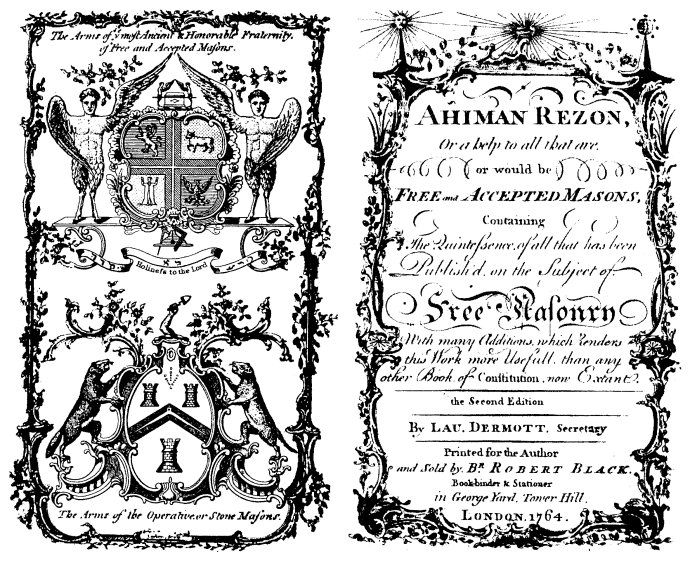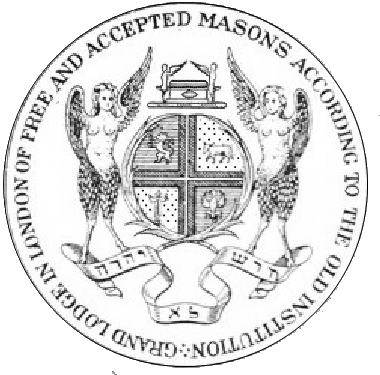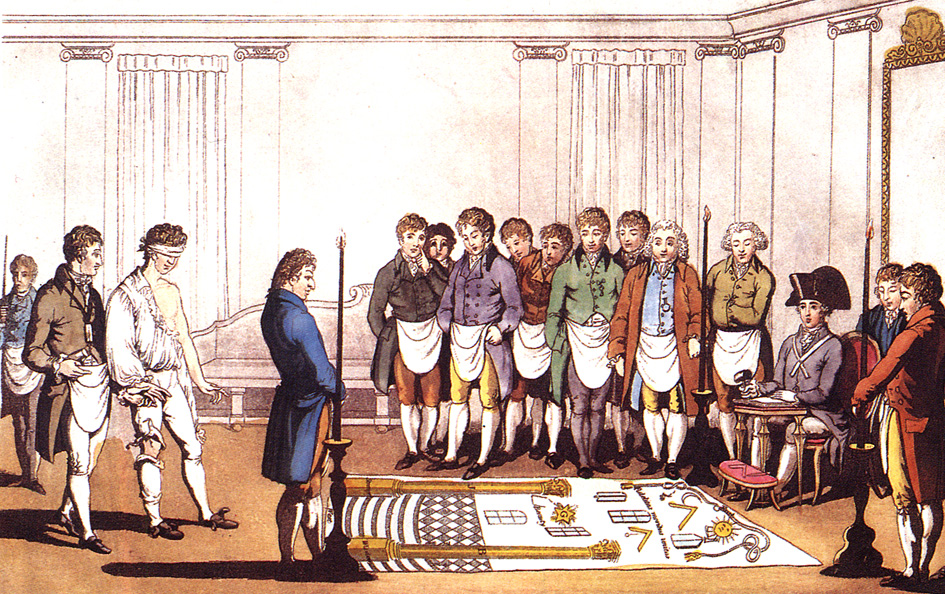|
Ahiman Rezon
The ''Book of Constitutions of this Grand Lodge'' or ''Ahiman Rezon'' (אֲחִימָן רְזוֹן) was a constitution written by Laurence Dermott for the Ancient Grand Lodge of England which was formed in 1751. The formation of the Ancient Grand Lodge brought together lodges and Masons who, believing themselves to be part of an older, original Masonic tradition, had chosen not to ally themselves with the previously formed Moderns Grand Lodge of 1717. Title The title ''Ahiman Rezon'' has been often said to be of the Hebrew language and variously mean "to help a brother", "will of selected brethren", "The secrets of prepared brethren", "Royal Builders" and "Brother Secretary". Upon more inspection however the words Ahiman and Rezon are two Biblical figures. Ahiman was one of four Levite gatekeepers appointed by King David, the others being Shallum, Akkub, and Talmon who guarded the Holy of Holies. Rezon, a fallen prince, eventually came to lead a group of Marauders to seize S ... [...More Info...] [...Related Items...] OR: [Wikipedia] [Google] [Baidu] |
Ahiman Rezon 1756
Ahiman () is the name of two persons in the Bible: * One of the three giant sons of Anak (the other two being Sheshai and Talmai) whom Caleb and the The Twelve Spies, Israelite spies saw in Mount Hebron (Book of Numbers 13:22) when they went in to explore the promised land. They were afterwards driven out and slain (Book of Joshua, Joshua 15:14; Book of Judges, Judges 1:10). *A Levite who was one of the guardians of the temple after the Exile (1 Chronicles 9:17). The name means "brother of the right hand" / "brother of a gift", "liberal." References Beecher, Willis J"Ahiman" in the ''International Standard Bible Encyclopedia''. Set index articles on Hebrew Bible people Rephaites Levites Anakim he:ענק#הענקים במקרא {{Hebrew-Bible-stub ... [...More Info...] [...Related Items...] OR: [Wikipedia] [Google] [Baidu] |
Laurence Dermott
Laurence Dermott (; 1720 – June 1791) was born in Ireland and became a Freemason in 1741. He held various offices before being installed as Worshipful Master of Lodge No. 26 in Dublin on 24 June 1746. He moved to London in 1748, possibly working as a journeyman painter, and possibly with a view to expanding his father's business. He would later work as a wine merchant, like his father. He was married to Elizabeth Dermott but his will does not list any children. He lived in Aldgate, Mile End and Stepney. He served as Grand Secretary of the Ancient Grand Lodge of England from 1752 to 1771. He wrote and published the ''Book of Constitutions of this Grand Lodge'' for the Ancient Grand Lodge of England, which he titled the Ahiman Rezon. Above all, it was Dermott's drive and tenacity that is credited with turning an association of six London lodges in 1751 into a viable and successful Grand Lodge, with lodges throughout England and the colonies. Early life Laurence Dermott was born ... [...More Info...] [...Related Items...] OR: [Wikipedia] [Google] [Baidu] |
Ancient Grand Lodge Of England
The Ancient Grand Lodge of England, as it is known today, or ''The Grand Lodge of the Most Ancient and Honourable Fraternity of Free and Accepted Masons (according to the Old Constitutions granted by His Royal Highness Prince Edwin, at York, Anno Domini nine hundred and twenty six, and in the year of Masonry four thousand nine hundred and twenty six)'' as they described themselves on their warrants, was a rival Grand Lodge to the Premier Grand Lodge of England. It existed from 1751 until 1813 when the United Grand Lodge of England was created from the two Grand Lodges. They are now called the ''Antients'', in contrast to the ''Moderns'', the original Grand Lodge which its critics, notably Laurence Dermott, said had moved away from the ritual of Scotland, Ireland, and now the Antient Grand Lodge. This Grand Lodge was also informally called the ''Atholl Grand Lodge'' because the Third and Fourth Dukes of Atholl presided over it as Grand Masters for half of its 62-year existence. [...More Info...] [...Related Items...] OR: [Wikipedia] [Google] [Baidu] |
Premier Grand Lodge Of England
The organisation now known as the Premier Grand Lodge of England was founded on 24 June 1717 as the Grand Lodge of London and Westminster. Originally concerned with the practice of Freemasonry in London and Westminster, it soon became known as the Grand Lodge of England. Because it was the first Masonic Grand Lodge to be created, modern convention now calls it the Premier Grand Lodge of England in order to distinguish it from the ''Most Ancient and Honourable Society of Free and Accepted Masons according to the Old Constitutions'', usually referred to as the Ancient Grand Lodge of England, and the Grand Lodge of All England Meeting at York. It existed until 1813, when it united with the Ancient Grand Lodge of England to create the United Grand Lodge of England.Douglas Knoop, ''The Genesis of Freemasonry'', Manchester University Press, 1947 The basic principles of the Grand Lodge of England were inspired by the ideal of tolerance and universal understanding of the Enlightenmen ... [...More Info...] [...Related Items...] OR: [Wikipedia] [Google] [Baidu] |
Worshipful Company Of Masons
The Worshipful Company of Masons is one of the ancient Livery Companies of the City of London, number 30 in the order of precedence of the 110 companies. It was granted Arms in 1472, during the reign of King Edward IV; its motto is “God Is Our Guide”. The Masons’ Company (not to be confused with the Freemasons), which emerged in the late Middle Ages, played an important role in medieval and early modern London. It regulated the craft of stonemasonry, for example by ensuring that standards and the training of apprentices were properly maintained, at first just in the City of London, but subsequently also in the City of Westminster and seven miles from each. It was also an important social organisation in the lives of its members. Like most Livery Companies, it maintains its social function, but the Company’s economic and administrative role has changed over time and it no longer oversees the craft in this traditional way, although it remains actively involved in suppo ... [...More Info...] [...Related Items...] OR: [Wikipedia] [Google] [Baidu] |
Anderson's Constitutions
The history of Freemasonry encompasses the origins, evolution and defining events of the fraternal organisation known as Freemasonry. It covers three phases. Firstly, the emergence of organised lodges of operative masons during the Middle Ages, then the admission of lay members as "accepted" (a term reflecting the ceremonial "acception" process that made non-stone masons members of an operative lodge) or "speculative" masons, and finally the evolution of purely speculative lodges, and the emergence of Grand Lodges to govern them. The watershed in this process is generally taken to be the formation of the first Grand Lodge in London in 1717. The two difficulties facing historians are the paucity of written material, even down to the 19th century, and the misinformation generated by masons and non-masons alike from the earliest years. Freemasonry's long history includes its early development from organised bodies of operative stonemasons to the modern system of speculative lodge ... [...More Info...] [...Related Items...] OR: [Wikipedia] [Google] [Baidu] |
Masonic Manuscripts
There are a number of masonic manuscripts that are important in the study of the emergence of Freemasonry. Most numerous are the ''Old Charges'' or ''Constitutions''. These documents outlined a "history" of masonry, tracing its origins to a biblical or classical root, followed by the regulations of the organisation, and the responsibilities of its different grades. More rare are old hand-written copies of ritual, affording a limited understanding of early masonic rites. All of those which pre-date the formation of Grand Lodges are found in Scotland and Ireland, and show such similarity that the Irish rituals are usually assumed to be of Scottish origin. The earliest Minutes of lodges formed before the first Grand Lodge are also located in Scotland. Early records of the first Grand Lodge in 1717 allow an elementary understanding of the immediate pre-Grand Lodge era and some insight into the personalities and events that shaped early-18th-century Freemasonry in Britain. Other early d ... [...More Info...] [...Related Items...] OR: [Wikipedia] [Google] [Baidu] |
1751 Books
In Britain and its colonies (except Scotland), 1751 only had 282 days due to the British Calendar Act of 1751, which ended the year on 31 December (rather than nearly three months later according to its previous rule). Events January–March * January 1 – As the American colony in Georgia prepares the transition from a trustee-operated territory to a British colonial province, the prohibition against slavery is lifted by the Board of Trustees. At the time, the African-American population of Georgia is about 400 people who have been kept as slaves in violation of the law. By 1790, the slave population increases to over 29,000 and by 1860 to 462,000. * January 7 – The University of Pennsylvania, conceived 12 years earlier by Benjamin Franklin and its other trustees to provide non-denominational higher education "to train young people for leadership in business, government and public service". rather than for the ministry, holds its first classes as "The ... [...More Info...] [...Related Items...] OR: [Wikipedia] [Google] [Baidu] |
1764 Books
1764 ( MDCCLXIV) was a leap year starting on Sunday and is the fifth year of the 1760s decade, the 64th year of the 18th century, and the 764th year of the 2nd millennium. Events January–June * January 7 – The Siculicidium is carried out as hundreds of the Székely minority in Transylvania are massacred by the Austrian Army at Madéfalva. * January 19 – John Wilkes is expelled from the House of Commons of Great Britain, for seditious libel. * February 15 – The settlement of St. Louis is established. * March 15 – The day after his return to Paris from a nine-year mission, French explorer and scholar Anquetil Du Perron presents a complete copy of the Zoroastrian sacred text, the ''Zend Avesta'', to the ''Bibliothèque Royale'' in Paris, along with several other traditional texts. In 1771, he publishes the first European translation of the ''Zend Avesta''. * March 17 – Francisco Javier de la Torre arrives in Manila to become the new S ... [...More Info...] [...Related Items...] OR: [Wikipedia] [Google] [Baidu] |







